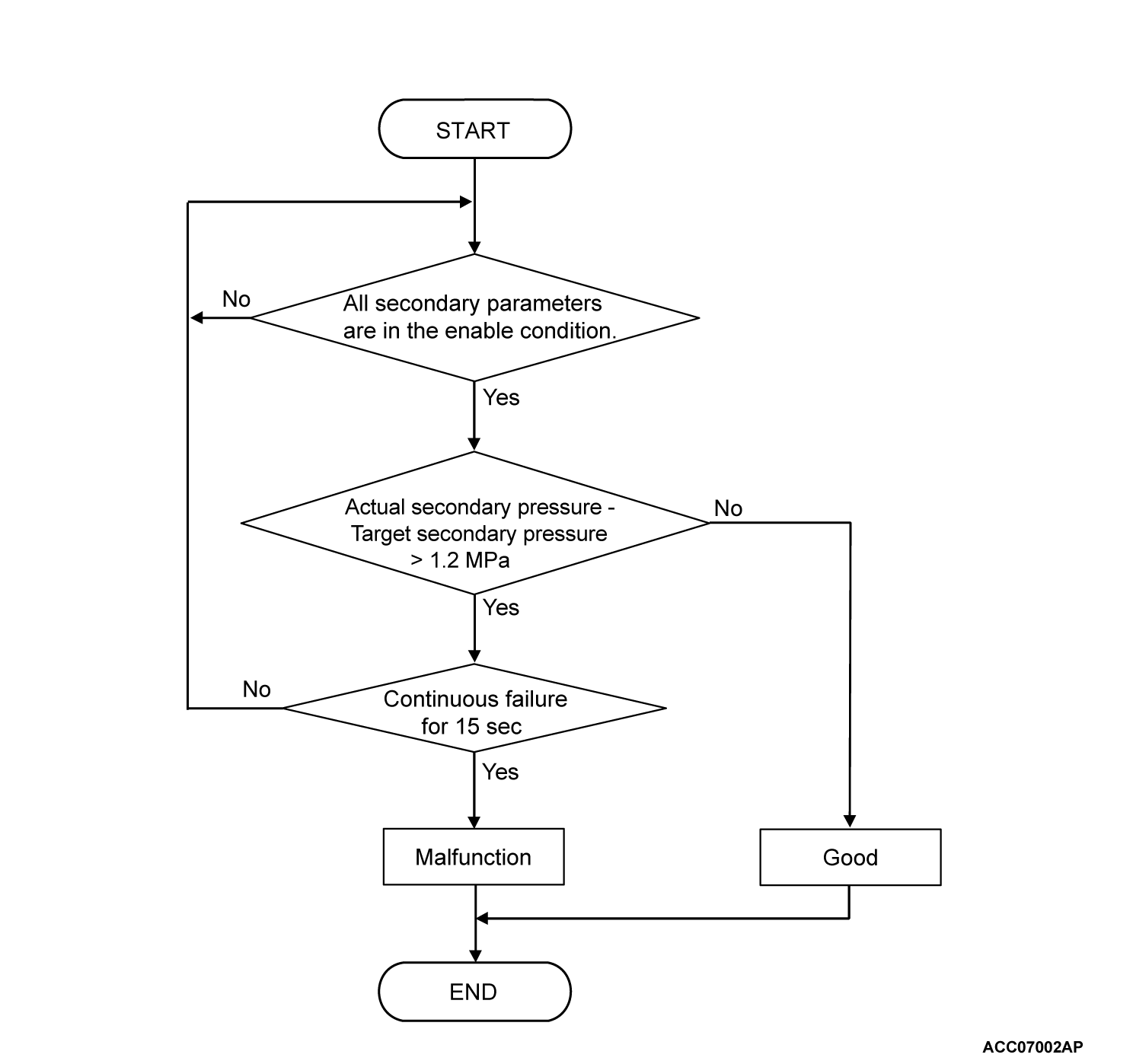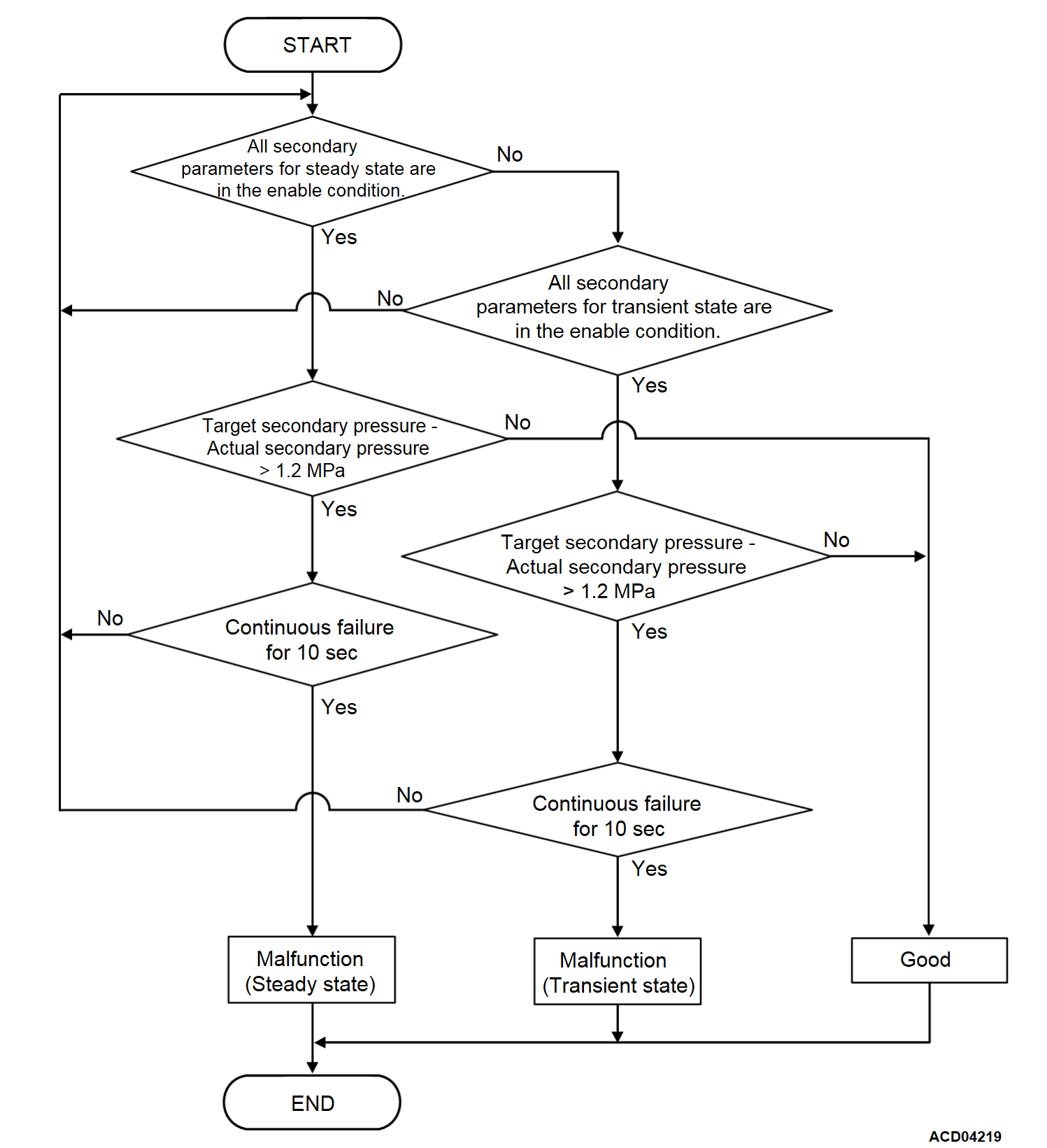DTC P0776: Abnormality in Secondary Pressure Solenoid Valve Function
DIAGNOSTIC FUNCTION
TCM conducts fault detection by measuring the difference between the target value and the actual value for the secondary pressure.
DESCRIPTIONS OF MONITOR METHODS
The following three conditions are met for 10 seconds.
- The engine is running.
- Selector lever position: Other than P, N
- Fluid temperature: More than -20°C (-4°F)
- Difference between the target secondary pressure and actual secondary pressure is 1.2 MPa (174 psi) or more.
MONITOR EXECUTION
- Voltage of battery: 10 volts or more.
MONITOR EXECUTION CONDITIONS (OTHER MONITOR AND SENSOR)
Other Monitor (There is no temporary DTC stored in memory for the item monitored below)
- Not applicable
Sensor (The sensor below is determined to be normal)
- Not applicable
DTC SET CONDITIONS
Check Conditions <Output Functional High>
- Voltage of battery: 10 volts or more.
- Transmission range switch position: D or R.
Check Conditions <Output Functional Low (Steady state)>
- Voltage of battery: 10 volts or more.
- Transmission range switch position: D or R.
- Engine speed: 450 r/min or more.
- Target secondary pressure: 0 MPa (0 psi) or more.
- Time since following conditions are approved: More than 1.52 seconds. [2 times (Interval: 30 second)].
- Target secondary pressure - Actual secondary pressure: 0.25 MPa (36 psi) or more.
- Actual secondary pressure: Less than minimum line pressure.
- Accelerator pedal position change rate: 6.25% / 1.52 seconds or less.
- Vehicle speed change rate: 15 km/h (9 mph) / 1.52 seconds or less.
Check Conditions <Output Functional Low (Transient state)>
- Voltage of battery: 10 volts or more.
- Transmission range switch position: D or R.
- Engine speed: 450 r/min or more.
- Target secondary pressure: 0 MPa (0 psi) or more.
- Time since following conditions are approved: More than 1 seconds.
- MIN [(Target secondary pressure - Actual secondary pressure), (Minimum line pressure - Actual secondary pressure)]: 2 MPa (290 psi) or more.
Judgment Criteria <Output Functional High>
- Actual secondary pressure - Target secondary pressure: More than 1.2 MPa (174 psi) (15 seconds).
Judgment Criteria <Output Functional Low (Steady state)>
- Target secondary pressure - Actual secondary pressure: More than 1.2 MPa (174 psi) (10 seconds).
Judgment Criteria <Output Functional Low (Transient state)>
- Target secondary pressure - Actual secondary pressure: More than 1.2 MPa (174 psi) (10 seconds).
OBD-II DRIVE CYCLE PATTERN
The vehicle is driven for at least 10 seconds with the accelerator opening angle at 20% or more.
PROBABLE CAUSES
- Malfunction of valve body assembly (Faulty secondary pressure solenoid valve)
- Malfunction of the CVT assembly
DIAGNOSIS
STEP 1. M.U.T.-III diagnostic trouble code
Is diagnostic trouble code No. P0966 or P0967 set?
 Carry out the appropriate troubleshooting.
Carry out the appropriate troubleshooting.STEP 2. Measure the output wave pattern of the secondary pressure solenoid valve at TCM connector (SCLS terminal).
(1) Connect the CVT assembly connector.
(2) Selector lever position: L
(3) Drive at a constant speed of approx. 20 km/h (13 mph)
(4) Connect an oscilloscope, and measure the voltage between TCM connector SCLS terminal and body ground.
Is the check result normal?
STEP 3. Symptom recheck after erasing diagnostic trouble code
Turn the ignition switch to the "LOCK" (OFF) position, and wait for one minute. Then, drive the vehicle for a while and check again. Replace the CVT assembly.
Replace the CVT assembly.
Is the diagnostic trouble code set?
 Replace the CVT assembly.
Replace the CVT assembly.![[Previous]](../../../buttons/fprev.png)
![[Next]](../../../buttons/fnext.png)



